Even though stock markets are taking a beating as the ongoing coronavirus pandemic continues to rattle the economy, young investors are not scared. They’re still flooding into the market for the first time.
A dramatic sell-off in stocks in the last four months, combined with more time at home due to quarantine, has actually piqued new interest in the stock market from newbies.
All major online stock trading platforms have seen a surge in demand in recent months and new accounts spike in the first quarter. For online brokers, Q1 2020 saw a 170% spike in the number of users, many of them first-time investors, and over half of them 34-years-old or younger.
For those newbies, there are hundreds of advisors, agencies, websites…..aimed to help them to choose the best portfolio.
But the name of the game is diversification, and when safe havens fail you--as they are right now--and equities are growing more frightening by the day in times of pandemic and political uncertainty, some alternatives might be in order ...
#1 Peer-to-peer lending
The new craze in the investing world is peer-to-peer lending. This relatively new non-bank banking concept is a way of making loans and returning the proceeds of those loans to investors through an online service. It cuts out the middleman.
P2P platforms allow you to invest directly in the loans taken out by borrowers instead of investing your money through a bank in the form of money market funds and certificates of deposit. Loans are determined by credit grades, based on many factors such as the borrower’s credit score, income, amount, purpose and term of loan.
Using these platforms, yield-seeking investors provide unsecured loans to consumers and in turn they get an average annual return of 7.9 or 11 %. It’s not a huge return, but it’s attractive to the average Millennial that doesn’t have a ton of appetite for risk. And it beats saving account interest any day.
#2 Pokémon cards
Someone who blew their whole allowance on Pokémon cards, no matter how old they are, will not be judged any longer. There’s some serious collector cash to be made here--as long as you do your research and know what you’re doing before you dive in.
A single card could be worth upwards of $200,000.
In October 2019, the “Pokemon Illustrator Card” sold for $224,250 at auction. And plenty of others have sold from $10,000 to $100,000, depending on how rare they are.
However, this is a potential minefield, too, littered with knock-offs that could lose you big bucks. and those items will need thorough authentication, maybe even more detailed than next type of investment.
#3 Art
The art market is also a great place for people looking for alternative investment opportunities.
And while owning a Picasso or a Van Gogh will is a status symbol, you don’t have to aim quite that high to get in on this opportunity.
In this high-tech digital age, there are platforms that allow investors to own a share of artwork for only a few hundred or thousand dollars and collect a profit once the art is re-sold. For those who are willing to take more risk, there are platforms focused on works by as-yet-undiscovered contemporary artists.
#4 Real-Estate Crowdfunding
Crowdfunding has grown hugely popular--so, why not extend it into real estate? It’s a relatively new concept of investment but it’s a brilliant one.
Crowdfunding platforms such as Crowdstreet, RealCrowd, RealtyMogul, Fundrise have raised billions of dollars from thousands of investors.
For a small amount of money, as low as $500, you can invest big real estate projects by teaming up with other investors on a single property or in a single real estate fund. You share the investment and receive a percentage of the revenue for either a sale or rental income.
#5 Watches
Watches are … well, timeless? Maybe not, unless you consider their investment potential.
Investment in the high-end watch market is another option for diversifying an investment portfolio. Even though watches are subject to trends and market sentiments, classic high-end watchmakers, such as Patek Philippe, almost never experience any value depreciation; nor, do they require much maintenance, so your investment is relatively safe.
It’s a good alternative to … say, owning gold, which has suddenly become less of a safe haven attraction. At least a watch has actual utility, and if you buy the right pieces, you’re not likely to lose out in a worst-case scenario.
By Michael Kern for Safehaven.com
More Top Reads From Safehaven.com:

















